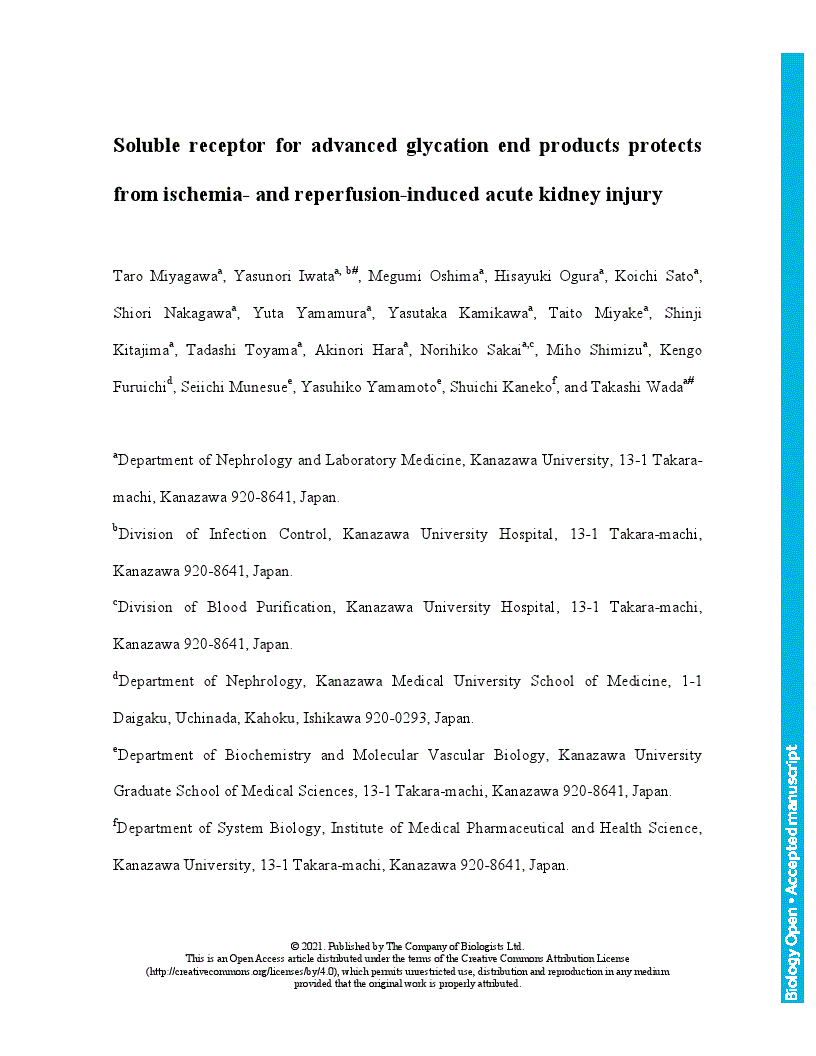The full-length receptor for advanced glycation end products (RAGE) is a multiligand pattern recognition receptor. High-mobility group box 1 (HMGB1) is a RAGE ligand of damage-associated molecular patterns that elicits inflammatory reactions. The shedded isoform of RAGE and endogenous secretory RAGE (esRAGE), a splice variant, are soluble isoforms (sRAGE) that act as organ-protective decoys. However, the pathophysiologic roles of RAGE/sRAGE in acute kidney injury (AKI) remain unclear. We found that AKI was more severe, with enhanced renal tubular damage, macrophage infiltration, and fibrosis, in mice lacking both RAGE and sRAGE than in wild-type control mice. Using murine tubular epithelial cells (TECs), we demonstrated that hypoxia upregulated messenger RNA (mRNA) expression of HMGB1 and tumor necrosis factor α (TNF-α), whereas RAGE and esRAGE expressions were paradoxically decreased. Moreover, the addition of recombinant sRAGE canceled hypoxia-induced inflammation and promoted cell viability in cultured TECs. sRAGE administration prevented renal tubular damage in models of ischemia/reperfusion-induced AKI and of anti-glomerular basement membrane (anti-GBM) glomerulonephritis. These results suggest that sRAGE is a novel therapeutic option for AKI.
Soluble receptor for advanced glycation end products protects from ischemia- and reperfusion-induced acute kidney injury
- Award Group:
- Funder(s): Japan Society for the Promotion of Science
- Award Id(s): grant number 19K23941
- Funder(s):
Currently Viewing Accepted Manuscript - Newer Version Available
- Split-screen
- Views Icon Views
- Open the PDF for in another window
-
Article Versions Icon
Versions
- Version of Record 04 February 2022
- Accepted Manuscript 23 November 2021
- Share Icon Share
-
Tools Icon
Tools
- Search Site
Taro Miyagawa, Yasunori Iwata, Megumi Oshima, Hisayuki Ogura, Koichi Sato, Shiori Nakagawa, Yuta Yamamura, Yasutaka Kamikawa, Taito Miyake, Shinji Kitajima, Tadashi Toyama, Akinori Hara, Norihiko Sakai, Miho Shimizu, Kengo Furuichi, Seiichi Munesue, Yasuhiko Yamamoto, Shuichi Kaneko, Takashi Wada; Soluble receptor for advanced glycation end products protects from ischemia- and reperfusion-induced acute kidney injury. Biol Open 2021; bio.058852. doi: https://doi.org/10.1242/bio.058852
Download citation file:
Advertisement
Read & Publish Open Access publishing: what authors say

We have had great feedback from authors who have benefitted from our Read & Publish agreement with their institution and have been able to publish Open Access with us without paying an APC. Read what they had to say.
Biology Open 2023 - a year in review

In this Editorial, BiO Editor-in-Chief Dan Gorelick reviews the journal's performance in 2023 and discusses his plans to improve author experience.
The Forest of Biologists
Our Publisher Claire Moulton recently visited the two Woodland Trust UK sites where we are planting new native trees for published Research and Review papers and protecting ancient woodland on behalf of our peer reviewers.
A Year at the Forefront

This series of Review articles aims to highlight the key discoveries, technological innovations, new resources and new hypotheses that have made an impact in a specific biological field during the past year. This publishing opportunity is available to early-career researchers, without a publication charge. Find out about eligibility and how to submit a proposal.
How we support early-career researchers

Biology Open, its sister journals and its not-for-profit publisher, The Company of Biologists, support early-career researchers in numerous ways, helping them grow their network and raise their profile. Find out what we can do to support you.



